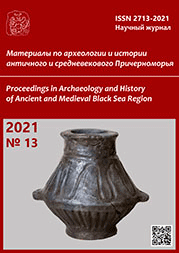New materials on sacrificial animals in Yanglang Culture burials of the 5th — 3rd cc. BCE (China)
New materials on sacrificial animals in Yanglang Culture burials of the 5th — 3rd cc. BCE (China)
Author(s): Daniil Shulga, Petr I. ShulgaSubject(s): History, Archaeology, Cultural history, Ancient World
Published by: Нижневартовский государственный университет
Keywords: Northern China; Scythian time; Yanglang Culture; Western rong; burial rite; sacrificial animals; nomads’ herd composition; burials of chariot warriors;
Summary/Abstract: This article focuses on the analysis of the sacrificial animals remains in burials of the 5th — 3rd сс. BCE of the Yanglang Culture Wangdahu burial ground identified with the Western Rongs who lived on the Qin kingdom western borders. As a rule, Eurasia Cattle breeders placed one or two parts or livestock carcasses in ordinary burials. In contrast to them, in the Yanglang Culture in one person ordinary burial up to 30, 50 or more skulls of all major livestock species (horses, cattle, sheep and goats) could be placed. In the analysis of sacrificial animals from the Yanglang Culture burial grounds detailed description, the authors came to the conclusion that in a number of burials the composition of animal species and their ratio fully correspond to the Central Asia nomads’ herd averaged data. Apparently, the burial grounds organizers were sent real herd to the other world with the dead people or recruited animals for slaughter keeping the proportions known to them. The proportion of horses is much higher in the chariot warriors` burials which is associated with the deceased special status. As it turned out, even 1—3 years old children could have such status during burial in Wangdahu. Foals and votive weapons full set were placed in such burials. All of this suggests the chariot warrior’s high status which was established in the funeral rite. The maintenance and training of chariot horses large number, the horses and chariot warriors equipment manufacturing required the state structures participation. It is no coincidence that the number of chariots served as a state power yardstick in ancient China. All these preliminary observations and conclusions are consistent with indirect information from Chinese historical sources about the developed horse breeding among the Western Rongs, their special relationship with the Qin kingdom and possibly the early state formation existence among them.
Journal: Материалы по археологии и истории античного и средневекового Причерноморья
- Issue Year: 2021
- Issue No: 13
- Page Range: 453-466
- Page Count: 14
- Language: English

